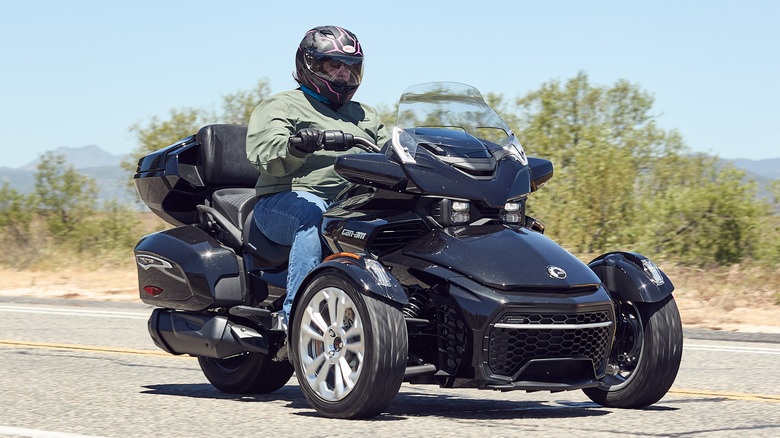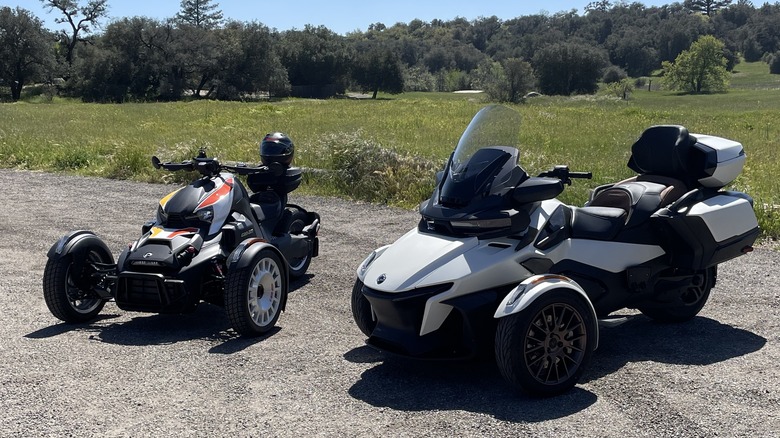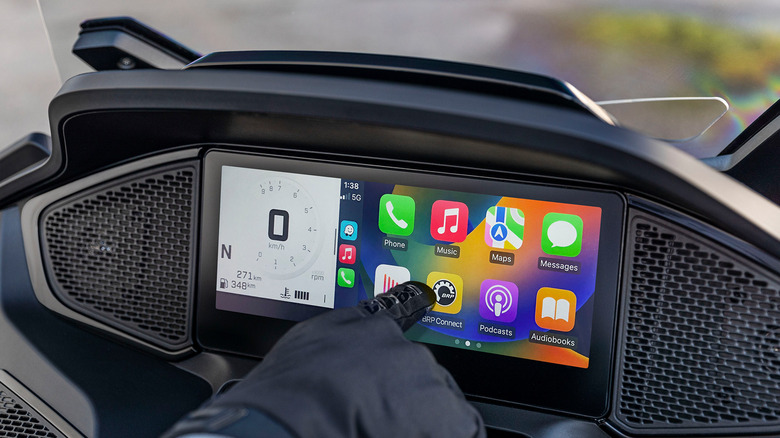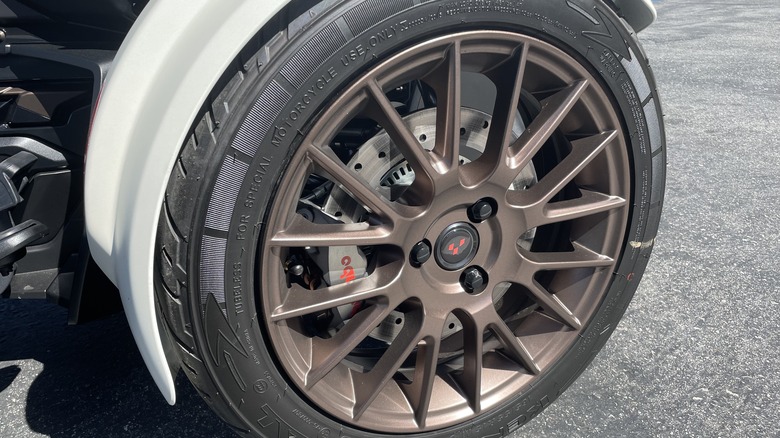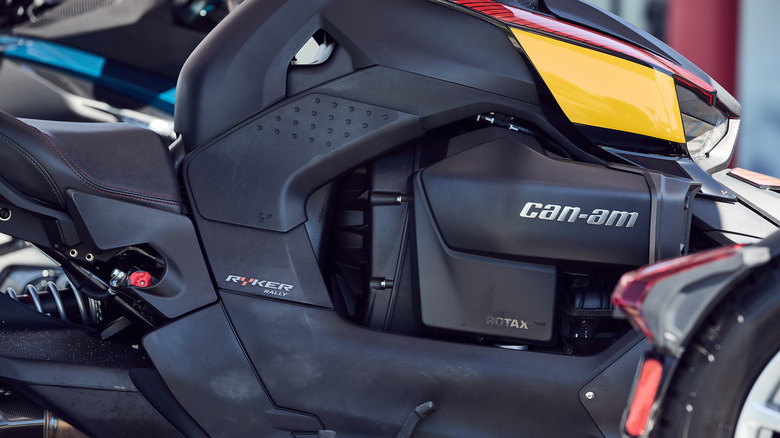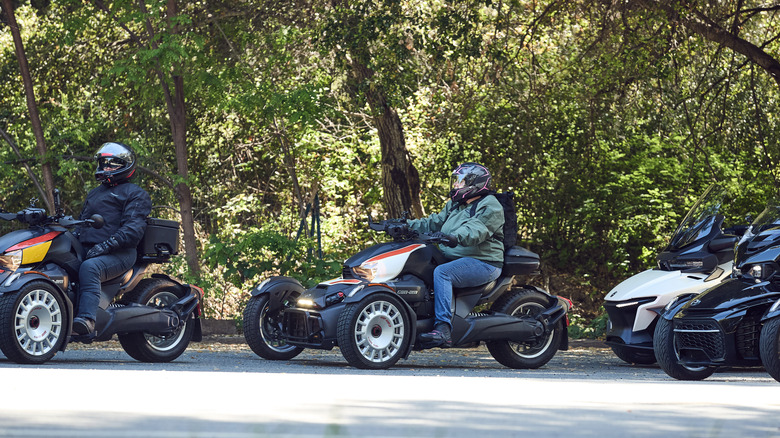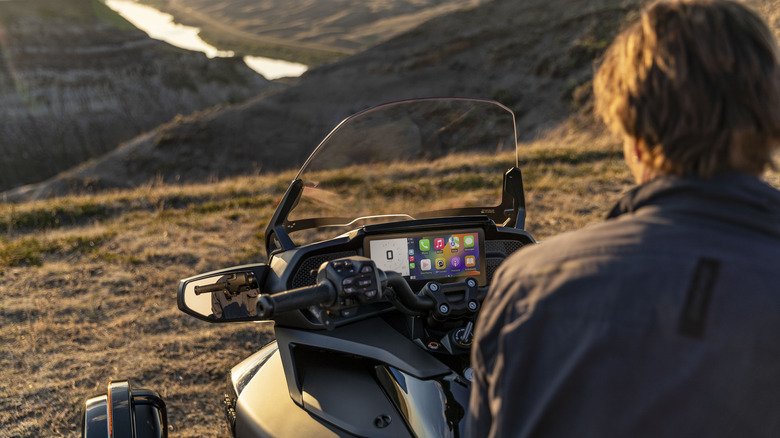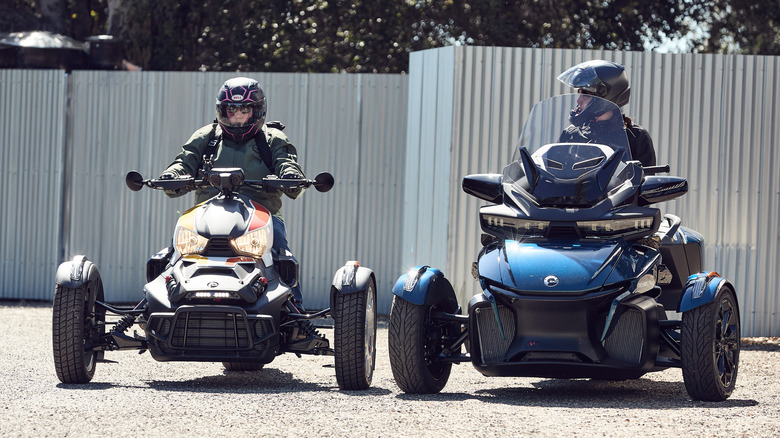2024 Can-Am Spyder And Ryker Review: 3-Wheel Pros And Cons, Whatever Your Budget
- Spyder has more creature-comforts than most bikes
- No shortage of power
- Ryker is affordable for a weekend toy
- Spyder is expensive
- Open-air design limits playtime
Let's talk a bit about riding, and why you'd want to give it a shot even if you don't currently ride, and how you'd go about doing that if you're totally inexperienced. Or, even if you have minimal experience. I've racked up some hours riding small two-wheeled vehicles–a Honda Grom, for example, and a Genuine Buddy 150–for short jaunts on dense city streets.
Yet, the Can-Am Spyder and Ryker are enough outside my comfort zone that I initially felt apprehensive, particularly for a 150-mile tour of Southern California's mountains and deserts. My preconceived notions proved correct: trikes, or 3-wheelers, combine the most draining aspects of riding a motorcycle, with the most overwhelming aspects of driving a tech-heavy, feature-laden modern car (even if state-by-state rules for trikes like the Slingshot, for things like helmets and licenses, swing between those two extremes).
Despite all that, there's something special and unique about the experience, not the least of which because a group of hot women riding together in celebration of International Female Ride Day, traditionally the first Saturday in May, creates a collective confidence and an awesome time. Here's what I learned about the 2024 Can-Am Spyder and Can-Am Ryker.
What's new for 2024
For 2024, Can-Am updates the brand's three-wheeled motorcycle lineup with new trim levels and new technology. It's most notable on the flagship Spyder series, with the Spyder F3 and RT getting a new 10.25-inch infotainment display with Apple CarPlay, which replaces the old 7.8-inch LCD display. Though Android Auto is not available, Android phone users can access navigation and audio streaming via Bluetooth.
Spyder models now have integrated antennas, instead of external antennas. The model lineup consists of the F3-S, F3-T, F3 Limited, F3 Limited Special Series, and new RT Sea-To-Sky.
As for the 2024 Ryker lineup, that carries over mostly unchanged. The customizable body panels are now available with new colors, however, and Can-Am's most affordable model keeps what arguably draws the most attention: its price tag. It starts at $9,599 (plus transport and preparation) for the base trim, while even the 2024 Ryker Rally kicks off at just $14,599.
2024 Can-Am Spyder RT Sea-To-Sky power and technology
The 2024 Can-Am Spyder RT Sea-To-Sky is a two-passenger trike in Vegas White Satin. Most trim pieces are back, though this Can-Am has a color-matched lockbox, seats upholstered in brown with Sea-to-Sky embroidery, and bronze wheels fitted over big Brembo brakes. At the top of the Spyder lineup for 2024, it's a whopper of a three-wheeled bike, at $32,999, but it has as many creature comforts as a car.
Examples include lumbar support, a self-leveling suspension system, heated seats and handlebars, LED headlights, an adjustable windshield with memory settings, a 10.25-inch touchscreen infotainment system with Apple CarPlay (which I unfortunately couldn't try myself, due to connectivity issues) and Bluetooth, and a six-speaker audio system.
For 2024, the infotainment display is the big news. While Apple CarPlay was inoperable on our test bike because it was in need of an over-the-air update, the touchscreen itself was clear, crisp, easy to see, and responsive, even when wearing gloves. This Can-Am has 115 horsepower and 96 pound-feet of torque courtesy of a 1330cc inline three-cylinder engine, paired to a six-speed semi-automatic transmission with reverse.
Spyder ride impressions
Shifting the Spyder took a few minutes of practice, but if you mess up by forgetting to shift, you'll be reminded when the engine starts screaming. No worries about downshifting; the Spyder does this automatically as it slows down. It's not as easy as a twist-and-go scooter or bike, but it's a lot less complicated than traditional motorcycle shifting (which is a lot more problematic if you get it wrong).
On the road, the Spyder is smooth, though its heft initially makes it a little difficult to get into the proper frame of mind to lean into a turn, for a couple of reasons. It feels, at first, as if no amount of leaning could possibly affect the trike's course, and a deliberate push/lean into the handlebars takes effort against the snug seat and relaxed riding position. It might take some practice to get over that mindset, but it's well worth it.
The Spyder becomes much more agile as you learn to move with it, and provides a relaxed ride overall. Vigilance is key, of course, but on the roads outside San Diego, the Spyder yielded plenty of mental and physical bandwidth to enjoy the surroundings.
2024 Can-Am Ryker Rally power and technology
The rugged 2024 Ryker Rally, meanwhile, features a 900cc inline three-cylinder engine rated for 82 horsepower and 58.3 pound-feet of torque, with a CVT transmission with reverse. That's the bigger engine option offered on the cheapest Ryker trim, which comes as standard with a Rotax 600cc engine boasting 50 horsepower and 36.7 lb-ft of torque.
Even with the better engine, the Ryker Rally's double wishbone front suspension and multi-link rear suspension offer up a visceral connection to the ground, especially when the pavement ends. The aluminum 16-inch front wheels and 15-inch rear wheel are fitted with rally tires, and the Ryker seats just one as standard. Can-Am does offer a passenger seat as a $350 option.
Overall, though, it's absent the creature comforts of the Spyder, by design, though it still has a 4.5-inch digital display and two USB ports. An audio system is an extra $800, while heated driver grips add $300.
Ryker ride impressions
I might have liked the Ryker more, had I ridden it first, but I ended up with the Ryker in the afternoon, after a lazy lunch, after more sun-drenched miles on the Spyder than I've put on my own bikes since before my kid was born. That's just context; I know it's not the Ryker's fault. The other women in our group clamored to get the Ryker first, and at the time I was happy to accommodate.
All that said, the Ryker is rough, and it's supposed to be. In some ways, it's a lot easier to ride—smaller and lighter, with less complicated infotainment, no shifting, and more steering feedback—but the vibrations of every speed bump, roadkill, and gravel patch are transmitted directly through the tires into the trike's frame, whereupon it promptly flows into the seat and up your spine. For the mere fact that the Ryker exhausted me, I preferred the Spyder.
However, I daily-drive a coarse manual-transmission sports sedan and am no stranger to testing SUVs on off-road courses, so I still very much appreciate what the Ryker is trying to do. And, at a cost of about a third of the Spyder, the Ryker is quite successful. In retrospect, if it was my own money on the line, I'd give the Ryker another go before stepping up to the Spyder.
Perfectly imperfect
As the pricing and specs indicate, these trikes are drastically different. That makes sense: they're designed to appeal not only to different budgets, but to different types of riders. The Spyder is like a luxury vehicle, especially in its top trim level. It's dense; it provides as much of a cocoon as possible without being inside, you know, an actual car. Since I rode the Spyder for the first half of our trip, it still felt relatively rough and exposed, and had a significant learning curve. Of the two, the Spyder definitely requires more of its rider in terms of attention and sensory input, considering the upshifting and the numerous infotainment features (which, again, we didn't really get acquainted with during this test, which was frankly a relief for the relative simplicity).
The Ryker is rougher, more rugged. While the Spyder feels a bit like a car missing its doors, the Ryker comes across more like a four-wheeler that could go anywhere it wants, though not necessarily anyplace it should. (We didn't off-road the Ryker, for the record, though dirt and gravel parking lots provided some interesting texture for contrast). The Ryker, with its simple digital display and automatic transmission, demands less of its pilot in terms of things to do, but that's a good thing, because it's exhausting in a good way. They really are two wholly different experiences: the Spyder definitely isn't simply a Ryker with $20,000 more in tech features.
2024 Can-Am Spyder and Ryker Verdict
If the Can-Am lineup is collectively an enabler, in terms of enjoyment, that's not entirely a bad thing. They're hugely impractical in many parts of the country, costing nearly as much as a new car and taking up almost as much space, yet without providing the flexibility of all-climate commuting — or even most-climate recreation. You can't accurately assess the benefits and drawbacks of such a vehicle without blatant acknowledgement that they're largely expensive toys.
It's hard to compare trikes to bikes, in large part because my experience with bikes is largely an upright riding position and these trikes are more relaxed, though not reclined. The Spyder would make a compelling alternative to, say, a brand-new Mazda MX-5 Miata (or, for those preferring three wheels but a car-like seating position, something like the Polaris Slingshot), while the Ryker might best be compared to a coarse used Miata that has hard-earned battle scars from weekends at the track. And that's really the best way to compare them to each other, in terms of pricing, features, and comfort. I preferred the Spyder overall because it's less physically exhausting to ride, while most of the other women I was riding with preferred the Ryker specifically for its ruggedness.
There are a fair few Can-Am and competitor trikes street-parked in my part of Chicago, and a fairly common sight on the highway and along the lakeshore on gorgeous summer weekends. I can't say the 2024 Can-Am trike has made me a convert, not at this point in my life, but they did make me long for the camaraderie of getting back on one of my little bikes.
